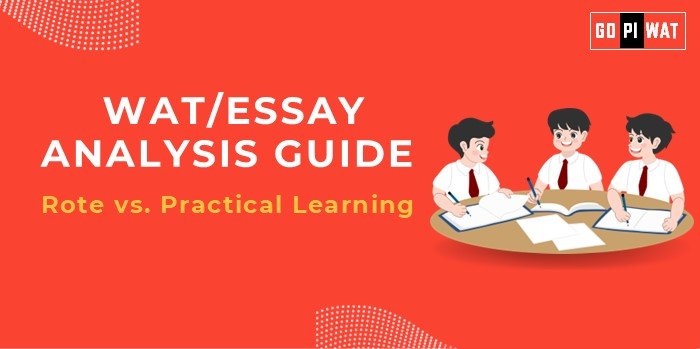📋 Rote vs. Practical Learning – WAT/Essay Analysis Guide
🌐 Understanding the Importance of Rote vs. Practical Learning
This topic is essential for discussing the effectiveness of educational methods.
For B-schools, it reflects a candidate’s ability to critically assess learning approaches and their implications on employability and problem-solving in professional settings.
📝 Effective Planning and Writing
- ⏳ Time Allocation: 5 minutes for planning, 20 minutes for writing, 5 minutes for review.
- 🔍 Preparation Tips: Identify relevant statistics, case studies, and stakeholder impacts.
💡 Introduction Techniques for Essays
- 🔄 Contrast Introduction: “While rote learning focuses on memory, practical learning emphasizes real-world application, making it a crucial skill in today’s dynamic job market.”
- 🤝 Solution-Based Introduction: “Shifting to a practical learning approach could help bridge the employability gap, a growing concern in India’s educational landscape.”
- 📜 Historical Context Introduction: “From colonial education systems rooted in rote learning to modern calls for experiential learning, India’s educational journey reflects both evolution and stagnation.”
🏗️ Structuring the Essay Body
- 🏆 Achievements: Highlight success in Atal Tinkering Labs, project-based learning initiatives, and the integration of experiential learning in NEP 2020 policies.
- 🔍 Challenges with Comparative Analysis: Outline systemic resistance, infrastructure gaps, and refer to successful global models in countries like Finland.
- 🌟 Future Outlook: Emphasize policy reforms, industry partnerships, and increased funding for practical education methods.
📈 Concluding Effectively
- ⚖️ Balanced Perspective Conclusion: “While rote learning lays a necessary foundation, embracing practical learning is essential for a holistic educational experience that meets the needs of the modern workforce.”
- 🌏 Global Comparison Conclusion: “As countries worldwide shift towards experiential education, India’s journey toward practical learning could redefine its global educational standing.”
🔍 Analyzing Successes and Shortcomings
- 🏆 Key Achievements: Integration of experiential learning under NEP, growth of Atal Tinkering Labs, and rising adoption of industry-focused curricula.
- ⚠️ Ongoing Challenges: Resistance to change in traditional schools, limited funding, and exam-centric system.
- 🌎 Global Context: Finland’s model for experiential learning demonstrates improved creativity and engagement, offering a benchmark for India.
🌟 Recommendations for Sustainable Progress
- 🔄 Incorporate Hybrid Models: A blend of rote and practical methods can help ease the transition.
- 🌐 Expand Infrastructure Investment: Increase funding for labs and practical learning facilities.
- 📚 Policy Advocacy: Promote educational policies that support innovation and experiential learning.
📄 Sample Short Essays
- ⚖️ Balanced Perspective: “Rote learning provides foundational knowledge, but to truly excel, integrating practical experiences is essential. This dual approach ensures both theoretical grounding and hands-on expertise, vital for today’s complex world.”
- 🤝 Solution-Oriented: “India’s education system must shift from rote learning towards practical applications, ensuring students acquire skills that improve employability and meet industry demands.”
- 🌍 Global Comparison: “Countries like Finland have shown the benefits of practical learning. India, with its large youth population, could greatly benefit from adopting similar models to foster innovation and skill development.”


